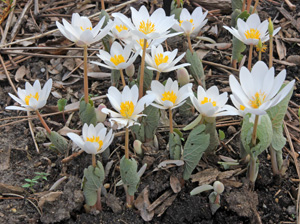
Very early in the spring, native wildflowers begin blooming in the forests of Wisconsin. One of the most easily recognizable of these wildflowers is bloodroot, an herbaceous perennial native to eastern North America, from Florida up into Canada. Sanguinaria canadensis is the only species in this genus in the poppy family (Papaveraceae). Other common names include bloodwort, Indian paint, puccoon, and red puccoon. This species is found in
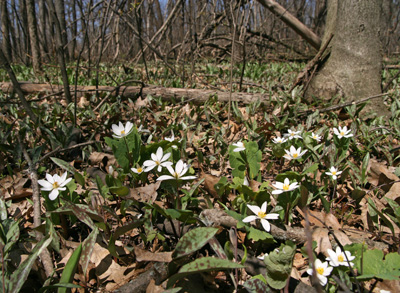
undisturbed woodlands, on flood plains and on slopes near streams or ponds in zones 3-8. It is generally rare but can be locally abundant. The reddish sap that exudes from all parts of the plant, but especially the root, when cut is what prompted the common name of bloodroot.

This species grows in clumps, producing leaves and flowers early in the season, then going dormant and disappearing by midsummer. The range in the shape of the leaves and flowers led to divisions into several subspecies, although most taxonomists now consider this just a highly variable species. The flowers and leaves are produced from a shallow-growing, branching, orange-colored rhizome. The rhizome, which is about one-half inch thick and up to four inches long, grows slowly, eventually branching to form a large colony. Bloodroot, used medicinally by Native Americans, contains compounds that are skin irritants and ingestion is not recommended.
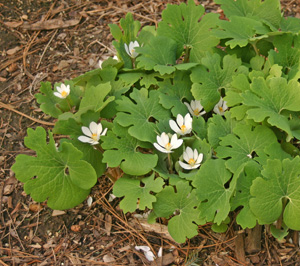
Bloodroot is used as a natural red or yellow-orange dye.
The brilliant white – or rarely light pink – flowers up to 2 inches across open in early spring. The blooming period lasts about 2 weeks. Each flower stalk produces a solitary flower with a number of delicate, elongate petals surrounding the numerous yellow stamens and central green pistil, with a pale yellow, two-lobed stigma at its apex. The flower usually has eight symmetrically arranged petals, with four large petals and four smaller ones. Some forms have up to sixteen petals. The flowers open up in sun but close at night or on very cloudy days (when their bee and fly pollinators are not active). The flowers are ephemeral, with the petals falling within a day or two of pollination. The double forms persist longer, however, because those extra petals are really modified stamens, which reduces the chances of pollination – which makes these cultivars more desirable as garden plants. There are a number of semi-double and fully double cultivars, such as ‘Multiplex’ (= ‘Flore Pleno’); the double types are often sterile and will not multiply, except by division.

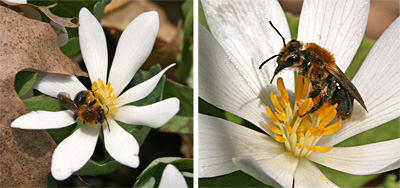
If pollinated, the flowers are followed by elongate seed pods. The two-part capsule is pointed on each end, with a row of 10-15 seeds in each half. The round, red to black seeds ripen by the time the foliage begins to senesce. When ripe, the pods split open to scatter the seed. The seeds have a fleshy organ called an elaisome that is attractive to ants. These insects disperse the seeds when they carry them back to their nests. The seeds are hauled out to the ants’ trash dump after the elaisomes are eaten and the seeds are protected within the pile until they germinate.
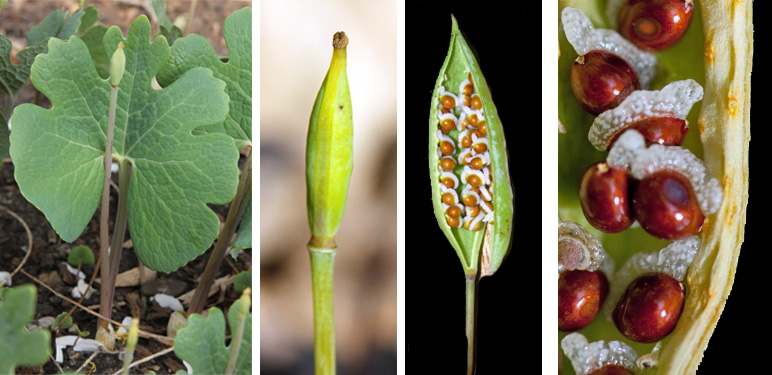
Leaves and flowers are produced from each end, or branch, of the horizontal rhizome. The plants bloom before the foliage unfolds, with each short (2-4″) flower stalk emerging wrapped by one tightly clasping basal leaf enclosing a flower bud which can be purple, yellow, white, or many shades of pink. The pale green to grayish- or bluish-green, palmate leaf is shorter than the flower pedicel and unfurls as the flower blooms. The rounded, multi-lobed leaves expand to their full size, up to 9 inches across after the flowers fade and the stalk elongates to 12-15 inches tall. Conspicuous venation on the whitish green lower leaf surface creates a reticulated appearance. The species is quite variable, with plants having 5 to 9 deeply-scalloped major lobes and several minor lobes along the undulating margins.


This native wildflower is best grown in moist, humusy, well-drained soils in part shade to full shade (in areas where it will receive sun for at least a few hours in early spring before the trees leaf out). In time it will spread to form large colonies if conditions are appropriate. It is perfectly suited to woodland gardens or any shady areas where the plants can be allowed to naturalize. It combines well with other native woodland wildflowers as well as ferns, hosta, and Virginia Bluebells to provide early season interest before the ferns and hostas emerge. Those plants will then cover up the bloodroot foliage as it senesces in mid summer when the plants go dormant.

Plants for the garden should be obtained from reputable sources that have not collected them in the wild. This plant can be propagated from fresh seed which should be sown immediately ½ inch deep and kept moist, even though it will not germinate until the following spring (or after several months of cold stratification). It will take 2 to 3 year for plants to reach blooming size. Colonies can also be transplanted but plants should not be collected from wild populations; over-collecting has led to dramatic declines in natural populations. They are best moved or divided as the plants are starting to go dormant in the summer (gloves should be worn when handling the roots, especially if they are being broken apart for divisions). Plants should be spaced about 6 inches apart with the rhizomes buried no more than an inch deep. It may take a year or more for plants to re-establish unless the roots are left undisturbed when moved.
– Susan Mahr, University of Wisconsin – Madison
Latest Horticulture News
Ask Your Gardening Question
If you’re unable to find the information you need, please submit your gardening question here:





 Alternatives to Lawn: Groundcovers
Alternatives to Lawn: Groundcovers Marigolds
Marigolds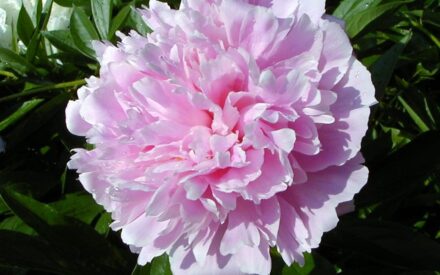 Peony
Peony Iris Severe Mosaic
Iris Severe Mosaic


